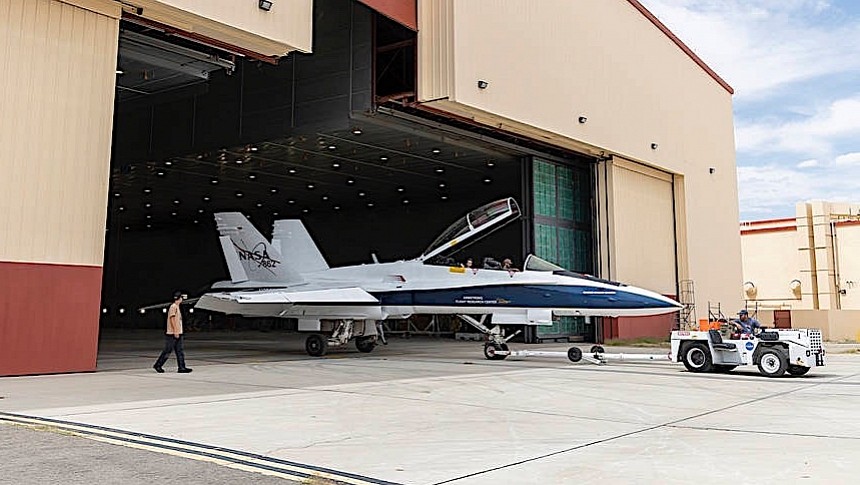For several years now NASA has been working on something called the X-59 QueSST. We're talking about an experimental aircraft meant to test a new design and new technologies for civilian supersonic flight.
The X-59 is still being put together, with the first flight scheduled to take place by the end of the year, if all goes according to plan. This story, however, is not about the QueSST, but about the planes that will chase after it.
Back in 2021, NASA revealed it will use an F-15 for the task. This plane will be used to go after the X-59 as it goes supersonic, trying to measure and visualize the sound waves it creates.
To be able to keep close enough for that to happen, the F-15, operated by NASA itself, has been fitted with a tool on its nose. Called Airborne Location Integrating Geospatial Navigation System (ALIGNS), it was designed as a means to allow the pilot of the fighter plane to coordinate their moves while flying at supersonic speeds behind the target.
It turns out such an important piece of equipment as the X-59 requires more than one chase plane. As revealed this week, an F/A-18 Hornet will go after the experimental plane as well, in a bid to "provide a platform for videographers and photographers to document flights."
The plane is a new addition to the NASA fleet, having been received from the U.S. Navy's Naval Air Station Patuxent River in Maryland back in 2021. It's a plane of the F/A-18D variety, meaning the kind used by the U.S. Marine Corps.
NASA spent the two years that have passed since it received the plane converting it for its own purposes. First up, all of the military bits were taken out (this operation alone took four full months). Then, the rear cockpit is where full aircraft controls were installed, as a means to train additional pilots to fly the thing.
Lastly, and most recently, the F-15 was stripped of its military colors and given the NASA work overalls in white and blue, and with all the proper markings. A new name was also chosen for it – more of a designation, really – and that's NASA 862. Up next is flight certification, and a career in the service of the world's most potent space agency that will probably span for more than four decades.
The F/A-18 was born in the back yard of McDonnell Douglas in 1974. It was designed as a twin-engine fighter jet with aircraft carrier capabilities, and so successful that some 1,500 units of it were made, in no less than eight variations for the U.S. military alone.
The current and most modern incarnation of the family is the Boeing-made Super Hornet, the "backbone of the U.S. Navy carrier air wing now and for decades to come."
Back in 2021, NASA revealed it will use an F-15 for the task. This plane will be used to go after the X-59 as it goes supersonic, trying to measure and visualize the sound waves it creates.
To be able to keep close enough for that to happen, the F-15, operated by NASA itself, has been fitted with a tool on its nose. Called Airborne Location Integrating Geospatial Navigation System (ALIGNS), it was designed as a means to allow the pilot of the fighter plane to coordinate their moves while flying at supersonic speeds behind the target.
It turns out such an important piece of equipment as the X-59 requires more than one chase plane. As revealed this week, an F/A-18 Hornet will go after the experimental plane as well, in a bid to "provide a platform for videographers and photographers to document flights."
The plane is a new addition to the NASA fleet, having been received from the U.S. Navy's Naval Air Station Patuxent River in Maryland back in 2021. It's a plane of the F/A-18D variety, meaning the kind used by the U.S. Marine Corps.
NASA spent the two years that have passed since it received the plane converting it for its own purposes. First up, all of the military bits were taken out (this operation alone took four full months). Then, the rear cockpit is where full aircraft controls were installed, as a means to train additional pilots to fly the thing.
Lastly, and most recently, the F-15 was stripped of its military colors and given the NASA work overalls in white and blue, and with all the proper markings. A new name was also chosen for it – more of a designation, really – and that's NASA 862. Up next is flight certification, and a career in the service of the world's most potent space agency that will probably span for more than four decades.
The F/A-18 was born in the back yard of McDonnell Douglas in 1974. It was designed as a twin-engine fighter jet with aircraft carrier capabilities, and so successful that some 1,500 units of it were made, in no less than eight variations for the U.S. military alone.
The current and most modern incarnation of the family is the Boeing-made Super Hornet, the "backbone of the U.S. Navy carrier air wing now and for decades to come."












